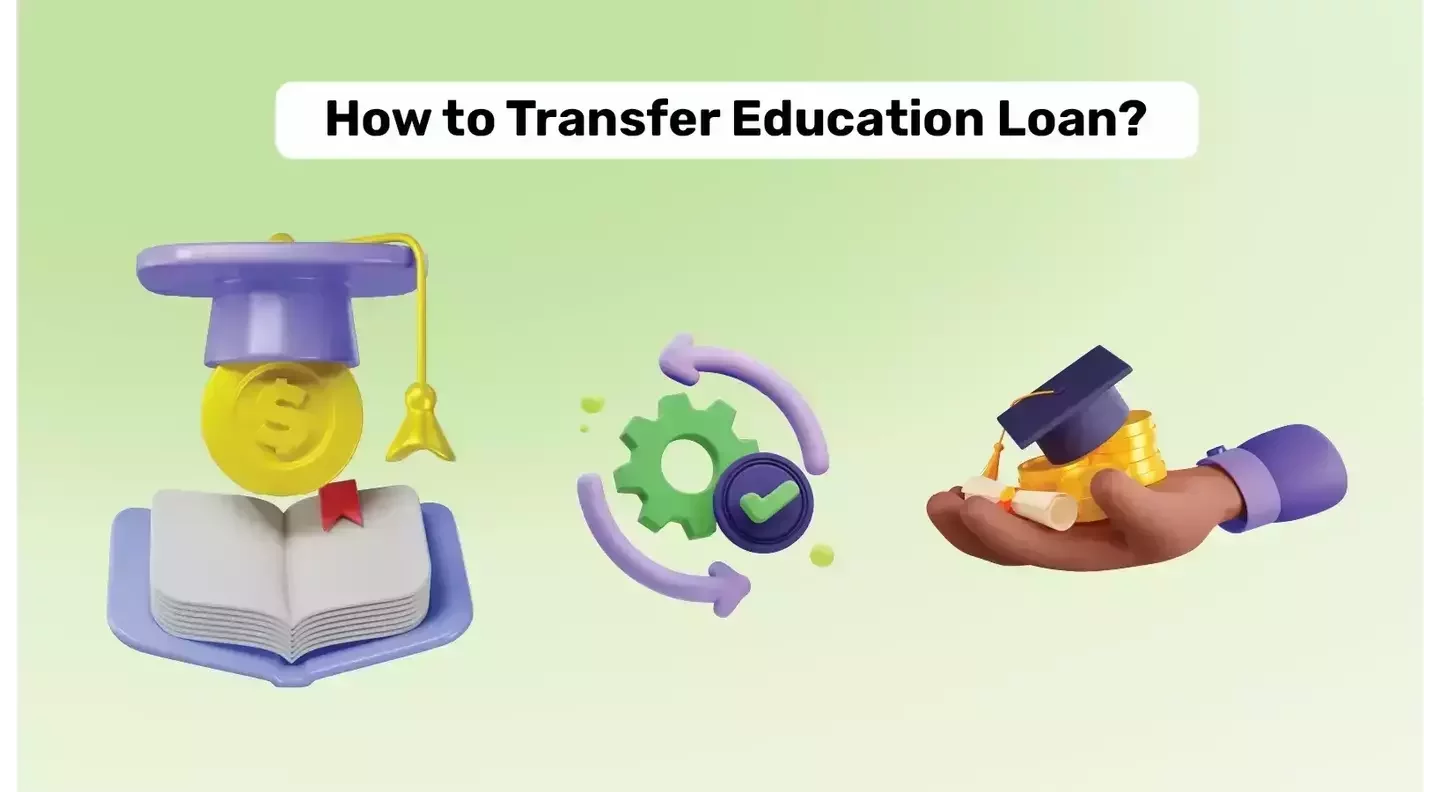Get instant loan offer suitable to your profile !


On this Page:
Learn how to transfer your education loan from one bank to another seamlessly. Discover the process, benefits and important tips to make the switch hassle-free.

Let’s say, Rohit, a postgraduate student took an education loan of INR 30 Lakh at 12%. His EMI was INR 43,566 and his total amount payable to the bank including the interest was INR 71,84,00. However, he transferred his loan to another bank with a 10% interest rate, where his EMI became INR 40,462. And his total amount payable became INR 63,12,000. Can you see the amount that Rohit will be saving? Can you imagine how much money you can save, even with a 2% lower interest rate? If you are wondering if we can transfer education loan from one bank to another?
The simple answer is yes, you can transfer your education loan to another bank. This process, known as an education loan balance transfer, involves moving your existing loan from one lender to a more favorable one. This decision can be motivated by several factors, such as lower interest rates, better service terms, or more beneficial repayment schedules offered by another bank.

Transferring an education loan from one bank to another is essentially the process of moving your existing loan debt from your current lender to a new one. This financial maneuver is typically pursued by borrowers seeking more favorable terms than those associated with their current loan. The decision behind seeking a new lender can vary widely but often revolves around issues like high-interest rates and rigid repayment policies that can make managing the loan more challenging and expensive over time.
Also read about: SBI’s Takeover Education Loan

Education loan transfers, also known as loan takeovers, can be categorized into four primary types. Below is a breakdown of these types:
This type involves transferring an education loan backed by collateral to a similar loan secured by collateral. In such scenarios, because the original collateral is tied up with the first loan, the transfer process is typically managed using photocopies of the collateral documents, as the originals are unavailable until the first loan is closed.
Initially, due to time limitations or the absence of required collateral documents, borrowers might opt for an unsecured education loan from private financial institutions or Non-Banking Financial Companies (NBFCs). However, as repayment commences, the higher cost of these loans becomes apparent. By then providing collateral, borrowers can transfer their loan to a secured one, often offered by government banks, which typically have lower interest rates, thus reducing the overall cost of the loan.
This scenario involves transferring an unsecured education loan to another unsecured loan. Borrowers might make this move to take advantage of specific benefits not offered by their original lender, such as tax-saving opportunities under certain provisions (like Section 80E in India), which allow for tax deductions on loan interest payments. This transfer often occurs between NBFCs and private banks.
Although less common, there are instances where a borrower might transfer a loan from being secured (backed by collateral) to unsecured (not backed by collateral). This usually occurs in situations where the collateral's owner intends to sell the asset and therefore needs to release it from the loan obligation. Despite the potential for higher interest rates with an unsecured loan, this option frees the collateral for sale.
Each of these transfer types offers different advantages and considerations, depending on the borrower’s circumstances, financial goals, and the availability of collateral. Understanding these categories can help borrowers make informed decisions when considering an education loan transfer.

The transfer process involves several key steps, which are generally as follows:
 Research and comparison: The borrower must first research potential new lenders, comparing interest rates, repayment terms, and other loan conditions to find the best offer.
Research and comparison: The borrower must first research potential new lenders, comparing interest rates, repayment terms, and other loan conditions to find the best offer.
 Check eligibility: Once a potentially better bank is identified, the borrower needs to ensure they meet this new bank's eligibility criteria for an education loan transfer.
Check eligibility: Once a potentially better bank is identified, the borrower needs to ensure they meet this new bank's eligibility criteria for an education loan transfer.
 Obtaining a No Objection Certificate (NOC): The current lender must provide a NOC, indicating they have no objections to the loan being transferred to another bank.
Obtaining a No Objection Certificate (NOC): The current lender must provide a NOC, indicating they have no objections to the loan being transferred to another bank.
 Application to the new bank: With the NOC and all required documentation, the borrower applies for the education loan transfer at the new bank. This application will include details of the current loan, academic progress, financial status, and any collateral or guarantor details.
Application to the new bank: With the NOC and all required documentation, the borrower applies for the education loan transfer at the new bank. This application will include details of the current loan, academic progress, financial status, and any collateral or guarantor details.
 Loan settlement and transfer: If the application is approved, the new bank will settle the outstanding loan amount with the current bank, effectively transferring the loan. The borrower will then commence repayments under the terms agreed upon with the new lender.
Loan settlement and transfer: If the application is approved, the new bank will settle the outstanding loan amount with the current bank, effectively transferring the loan. The borrower will then commence repayments under the terms agreed upon with the new lender.

While transferring an education loan can offer financial relief and better service, it's important to consider several factors:
 Costs involved: There may be processing fees, prepayment penalties from the current bank, and other charges associated with transferring the loan. These costs should be weighed against the potential savings from lower interest rates.
Costs involved: There may be processing fees, prepayment penalties from the current bank, and other charges associated with transferring the loan. These costs should be weighed against the potential savings from lower interest rates.
 Loan tenure: Transferring later in the loan tenure might not be as beneficial, as more of the interest has already been paid. Early in the loan period is generally the best time to transfer to maximize savings on interest payments.
Loan tenure: Transferring later in the loan tenure might not be as beneficial, as more of the interest has already been paid. Early in the loan period is generally the best time to transfer to maximize savings on interest payments.
 Terms and conditions: It’s crucial to thoroughly understand the new bank's terms and conditions to ensure they are indeed more favorable than your current loan’s conditions.
Terms and conditions: It’s crucial to thoroughly understand the new bank's terms and conditions to ensure they are indeed more favorable than your current loan’s conditions.

When considering transferring an education loan from one bank to another, borrowers must meet specific eligibility criteria to ensure a smooth transition. These criteria are designed to protect both the borrower and the receiving bank's interests, ensuring that the transfer is feasible and beneficial for all parties involved. Here's a clearer representation of the conditions under which an education loan transfer might be considered:
 Completion of disbursements: The borrower should have received all scheduled disbursements from the current lender, meaning no further funds are expected to be disbursed under the existing loan agreement. Essentially, the loan should be fully disbursed, with no additional borrowing anticipated from the original lender.
Completion of disbursements: The borrower should have received all scheduled disbursements from the current lender, meaning no further funds are expected to be disbursed under the existing loan agreement. Essentially, the loan should be fully disbursed, with no additional borrowing anticipated from the original lender.
 Commencement of repayment: The borrower must have started repaying the original loan through Equated Monthly Installments (EMIs). Regularity in these repayments is crucial, as inconsistent payments could negatively impact the borrower's credit score (CIBIL score), potentially hindering the transfer process.
Commencement of repayment: The borrower must have started repaying the original loan through Equated Monthly Installments (EMIs). Regularity in these repayments is crucial, as inconsistent payments could negatively impact the borrower's credit score (CIBIL score), potentially hindering the transfer process.
 For Secured Loans: If the current education loan is secured with collateral, the new lender will assume control over this collateral. The collateral will remain under the new bank's possession until the loan, along with any accrued interest, is fully repaid.
For Secured Loans: If the current education loan is secured with collateral, the new lender will assume control over this collateral. The collateral will remain under the new bank's possession until the loan, along with any accrued interest, is fully repaid.
 For Unsecured Loans Transferring to a Secured Loan: In cases where the original loan is unsecured and the borrower wishes to transfer to a secured loan, especially with a government bank, the borrower must provide suitable collateral. This new collateral is necessary for securing the loan with the new bank, which will then settle any outstanding dues with the previous lender. In such scenarios, the loan amount granted against the collateral typically covers 100% of the dues, without any margin required.
For Unsecured Loans Transferring to a Secured Loan: In cases where the original loan is unsecured and the borrower wishes to transfer to a secured loan, especially with a government bank, the borrower must provide suitable collateral. This new collateral is necessary for securing the loan with the new bank, which will then settle any outstanding dues with the previous lender. In such scenarios, the loan amount granted against the collateral typically covers 100% of the dues, without any margin required.

Education loan transfers in India can provide several financial and strategic advantages for borrowers looking to optimize their loan terms and overall repayment strategy. Here are the top five benefits of transferring an education loan to another bank in India:
 Lower interest rates: One of the primary benefits of transferring an education loan is the potential to secure a lower interest rate from another bank. A reduction in interest rates, even by a small percentage, can significantly decrease the total amount of interest paid over the life of the loan, resulting in substantial savings.
Lower interest rates: One of the primary benefits of transferring an education loan is the potential to secure a lower interest rate from another bank. A reduction in interest rates, even by a small percentage, can significantly decrease the total amount of interest paid over the life of the loan, resulting in substantial savings.
 Better repayment terms: Different banks offer varied repayment options and terms that might be more suited to a borrower's current financial situation. Transferring a loan can allow borrowers to benefit from more flexible repayment schedules, longer repayment periods, or more convenient EMI options, enhancing their ability to manage their finances more effectively.
Better repayment terms: Different banks offer varied repayment options and terms that might be more suited to a borrower's current financial situation. Transferring a loan can allow borrowers to benefit from more flexible repayment schedules, longer repayment periods, or more convenient EMI options, enhancing their ability to manage their finances more effectively.
 Access to enhanced services: Some banks may offer additional services, such as more accessible customer support, online account management, and flexible disbursement options. Transferring an education loan can provide borrowers with not only better financial terms but also an improved banking experience and additional conveniences.
Access to enhanced services: Some banks may offer additional services, such as more accessible customer support, online account management, and flexible disbursement options. Transferring an education loan can provide borrowers with not only better financial terms but also an improved banking experience and additional conveniences.
 Consolidation of loans: For borrowers managing multiple education loans, transferring them to a single lender can help consolidate the debts into one loan with a single monthly payment. This consolidation can simplify financial management, potentially offer lower interest rates, and extend repayment terms, making it easier to manage cash flow and budgeting.
Consolidation of loans: For borrowers managing multiple education loans, transferring them to a single lender can help consolidate the debts into one loan with a single monthly payment. This consolidation can simplify financial management, potentially offer lower interest rates, and extend repayment terms, making it easier to manage cash flow and budgeting.
 Release of co-applicant: In some cases, transferring an education loan to another bank might provide an opportunity to release a co-applicant (usually a parent or guardian) from the loan obligation. This can be particularly beneficial if the primary borrower is now financially stable and wishes to take full responsibility for the loan, thereby reducing the financial burden on the co-applicant.
Release of co-applicant: In some cases, transferring an education loan to another bank might provide an opportunity to release a co-applicant (usually a parent or guardian) from the loan obligation. This can be particularly beneficial if the primary borrower is now financially stable and wishes to take full responsibility for the loan, thereby reducing the financial burden on the co-applicant.
It's important for borrowers to carefully evaluate these criteria and ensure they are fully met before proceeding with an education loan transfer. Meeting these requirements not only makes the transfer process smoother but also positions the borrower to potentially secure better loan terms, such as lower interest rates or more favorable repayment conditions, with the new lender.
Transferring an education loan to another bank can be a strategic financial decision that potentially offers significant savings and more favorable repayment terms. The key to a successful transfer lies in careful planning, thorough research, and a clear understanding of one's financial situation and goals. Borrowers should weigh the immediate costs against long-term benefits, considering factors such as interest rates, loan tenure, and the terms and conditions of new loan offers. Furthermore, GyanDhan’s strategic negotiation support, leveraging strong banking relationships, often results in more favorable loan terms for borrowers. Their dedicated end-to-end support, addressing any concerns from the initial inquiry to the completion of the education loan transfer, underscores their commitment to borrower success. So, if you are someone who is looking to transfer their education loan, check your loan eligibility for free now.
Also read:

Yes, you can transfer your loan from one bank to another, subject to the terms and conditions of your current loan and the eligibility criteria of the new bank. This process is commonly done for education loans, home loans, and personal loans, mainly to benefit from lower interest rates or better loan terms.
Yes, student loans can often be transferred or refinanced to another lender. However, the transfer depends on the lender's policies, and refinancing usually involves taking a new loan to pay off the existing one. Always check the terms and conditions before proceeding.
Yes, you can take student loans from two different banks if you require additional funds that are not covered by a single loan or if you find that different banks offer loans that cater to specific needs (such as covering tuition vs. living expenses). However, it's crucial to manage the repayment obligations for multiple loans effectively. Be mindful of the cumulative debt and ensure that taking loans from multiple sources aligns with your financial capacity to repay them.
Check Your Education Loan Eligibility

Ask from a community of 10K+ peers, alumni and experts
Trending Blogs
Similar Blogs

Network with a community of curious students, just like you
Join our community to make connections, find answers and future roommates.. Join our CommunityCountry-Wise Loans
Best Lenders for Education Loan

ICICI Bank

Axis Bank

Union Bank

Prodigy

Auxilo

Credila

IDFC

InCred

MPower

Avanse

SBI

BOB

Poonawalla

Saraswat